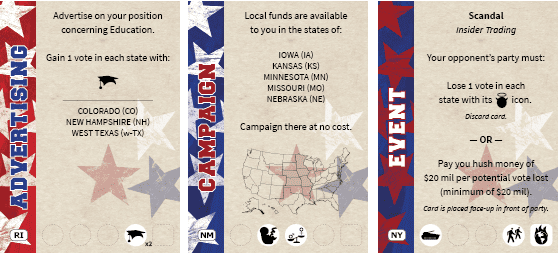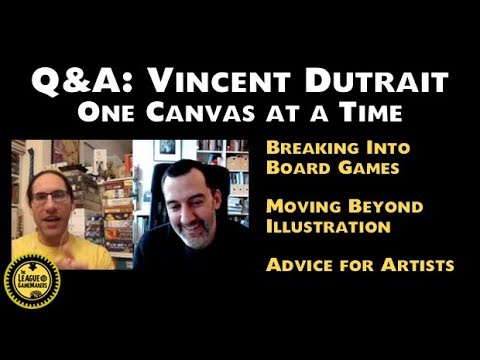
product made for leisure time enjoyment that refuses to be categorized into arbitrary and nebulously defined criteria vis-a-vis the combination of characteristics of the strong suits of various games and simulations in order to maximize the fun experience had by all.
For as long as I can remember my dad has been working on the design of a game based around a US presidential election. I remember playtesting with him when I was about 12 years old. So, of course when my brother and I decided to start our game publishing company we wanted to publish this game.
I want to talk to you about how we (well mostly my brother, Nathan. He did all the work) took a great political campaign simulation and tweaked it and modified it to include some elements of a political campaign game ending up with a fun juxtaposition of the two. Hopefully, you will learn something to inspire and help your design process along the way.
First of all, let’s talk about this whole concept of games versus simulation. There are some great simulations out there (SimCity, Minecraft, etc) and there are some great abstract games out there (Othello, Blockus, etc). For the purposes of this post, I am defining a simulation as an attempt to mimic reality as closely as possible. Therefore a game with no simulation properties would be purely abstract. As we all know a good game will include simulation properties as well as abstract properties. Teale Fristoe of Nothing Sacred Games wrote about this topic a while back and had lots of good things to say. I won’t cover what he already said about the importance of including fun and how mimicking reality can take away from that. What I want to ask is why do we feel the need to categorize games versus simulations at all? Why not just let a game be what it is? Some games are naturally going to mimic reality more than others. Some will only have a cursory connection with reality and will be driven by mechanics. We, as designers, should just be true to our vision and what we want others to feel as they play our games. I hope to show by using Campaign Trail as an example how this is possible. We have made some changes to make it more “game-like” but also kept some things in the game that really make it “simulation-like”. The result is a really fun political campaign game that has been a hit at Gen Con for the past two years!
THE EXPLORATORY COMMITTEE
When Campaign Trail first started out it was definitely heavy on the simulation side. The map included major cities as well as states in which players could campaign. The winner of each state was determined by a formula that looked something like this:
I jest, but it really was long and complicated. We decided that in order to make it a playable game, it didn’t need to fit reality exactly. There could be some leeway taken. The first of those changes was to get rid of all the cities. Now characters could only campaign and receive votes in states. While this change made the game significantly different than real life, it also made it easier to play and decreased the overall play time. A definite improvement by going toward the game side of the game/simulation spectrum.
THE PRIMARIES
The next thing we looked at was the weighting given to the parties for each state. Originally, each state had a weighting for both parties so that it would mimic the actual political leanings of the states. This resulted in pretty boring games. The Democrat always won certain states and the Republicans always won the rest of the states. We decided that a little weighting was good but not entirely mimicking reality. The solution was to create tracks with a maximum number of votes per party. In each state one party had a slight advantage by being able to place one more vote in that state than their opponent. This gave each party an opportunity to win each state with good planning and strategic moves. Now, you could have a Democratic stronghold in Texas and a Republican stronghold in New York.
Eventually we got rid of the max votes per state all together. We decided it made more sense to allow candidates to campaign in states as much as they desired. We did still keep the small advantage by having each state start with a vote for the party that holds an advantage in that state.
THE GENERAL ELECTION
Finally, we looked at how the turns were actually structured. Up until this point, the game was organized in rounds, with 3 phases per round. A player was required to play an advertising card during the advertising phase, a campaign card in the campaign phase, and an event card in the event phase.
We actually realized that this was an area where the “gaminess” of the game was getting in the way of the fun. In reality, a candidate doesn’t limit his or her actions to certain times. They make strategic decisions based on what they think is best for their campaign at the time. We wanted to incorporate this idea into the game. So, we created cards that contained all the various actions. Now, when a player plays a card, they choose which action they want to take with each card, giving them more choices and more strategic options.

THE INAUGURATION
There were a few other decisions we made in order to maintain the realism and simulation qualities of the game. One of these was keeping each individual state as a movement and vote allocation location. It was suggested to us to make some of the smaller states (ND, SD, MT, etc) into groups that candidates would campaign in all at the same time. We considered this but in the end thought that the game really benefited from allowing each state to be won individually.
The next piece we looked at was the electoral college. The game always did use the electoral college as a scoring system. One candidate gains 270 electoral votes and wins the game! However, it was also suggested that we modify the scoring system so there wasn’t such a wide swing in votes. For example, give CA 35 votes instead of 55 votes and give ND 10 votes instead of 3. While this guy might have a point when it comes to the real election, we determined that the electoral college makes for an exciting game and offers lots of strategic options.
The bottom line is there is no right answer to the question of “game versus simulation”. The question is what is best for your game? What are you trying to achieve and how can you incorporate reality as well as game mechanics to get that done? What have you done with your designs? How have you made them more simulation-like? What have you done to incorporate strong game mechanics and what parts of reality did you have to get rid of? Was it worth it? We would love to hear from you about your design process!








